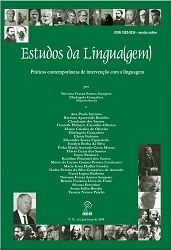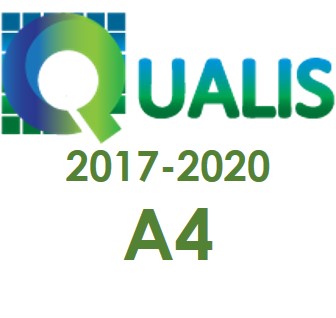Development of monozygitic twins: language and other specificities
DOI:
https://doi.org/10.22481/el.v17i1.5315Keywords:
Language; twins; language change.Abstract
This paper aims to discuss twinning, from the conception, the gestation, and the perinatal moment, to the issues of the uniqueness of “being identical twin" and language change. In this sense, the text emphasizes the importance that the family group of twins has in their formation and their identification as a social being, what occurs through language. Thus language is considered relevant in the process of individual constitution of the child as a social subject, while his identity constitution occurs in the context of relationships as well as in the social and intrafamily order.
Downloads
References
BAKKER, P. Autonomous languages of twins. Acta Genet Med Gemellol (Twin Res), n. 36, p. 233-238, 1987.
BARBETTA, N. L. Sobre o desenvolvimento de linguagem de gêmeos monozigóticos. Revista CEFAC, v. 11, suplemento 2, p. 154-160, 2009.
______.; PANHOCA, I. Gêmeos idênticos no grupo terapêutico fonoaudiológico: a construção da linguagem e da subjetividade. Pró-Fono Revista Atualização Científica, v. 15, n. 2, p. 139-148, 2003.
______.; ______.; ZANOLLI, M. L. Gêmeos monozigóticos: revelações do discurso familiar. Revista da Sociedade Brasileira de Fonoaudiologia, v. 13, n. 3, p. 267-271, 2008.
BEIGUELMAN, B. O estudo de gêmeos. São Paulo: Sociedade Brasileira de Genética, 2008.
______.; COLLETO, G. M. D. D.; FRANCHI-PINTO, C.; KRIEGER, H. Birth weight of twins: 2. Fetal genetic effect on birth weight. Genetics and Molecular Biology, v. 21, n. 1, p. 155-158, 1998.
______.; FRANCHI-PINTO, C. Perinatal mortality among twins and singletons in a city in southeastern Brazil, 1984-1996. Genetics and Molecular Biology, v. 23, n. 1, p. 15-23, 2000.
BISHOP, D. V. M. The underlying nature of specific language impairments. Journal of Child Psychology and Psychiatry, v. 33, n. 1, p. 3-66, 1992.
______.; BISHOP, S. J. Twin language: risk factor for language impairment? Journal of Speech, Language, and Hearing Research, v. 41, p. 150-160, 1998.
BRASIL. MINISTÉRIO DA SAÚDE. Indicadores Demográficos. In: ______. Indicadores e Dados Básicos – Brasil – 2012. Disponível em: < http://tabnet.datasus.gov.br/cgi/tabcgi.exe?sinasc/cnv/nvuf.def> e < http://tabnet.datasus.gov.br/cgi/tabcgi.exe?sinasc/cnv/nvuf.def>. Acesso em: 16 ago. 2017.
______. MS/SVS/DASIS – Sistema de Informações sobre Nascidos Vivos – SINASC – 2015. Disponível em: < http://tabnet.datasus.gov.br/cgi/tabcgi.exe?sinasc/cnv/nvuf.def>. Acesso em: 16 ago. 2017.
CAVALCANTI, A.; XAVIER, C. Aspectos do desenvolvimento da linguagem em crianças com história de prematuridade. Temas sobre desenvolvimento, v. 4, n. 22, p. 18-31, 1995.
CIAMPA, A. C. A estória do Severino e a história da Severina. São Paulo: Brasiliense, 2001.
CLARK, P. M.; DICKMAN, Z. Features of Interaction in Infant Twins. Acta Genet Med Gemellol, v. 33, p. 165-71, 1984.
DAY, E. The development of language in twins. Child Development, v. 3, p. 298-316, 1932.
DODD, B.; MCEVOY, S. Twin Language or Phonological Disorder? Journal of Child Language, v. 21, p. 273-90, 1994.
DOUGLAS, J. E.; SUTTON, A. The development of speech and mental processes in a pair of twins: a case study. Journal of Child Psychology and Psychiatry, v. 19, p. 49-56, 1978.
FRANCHI-PINTO, C.; COLLETO, G. M. D. D.; KRIEGER, H.; BEIGUELMAN, B. Genetic effect on apgar score. Genetics and Molecular Biology, v. 22, n. 1, p. 13-16, 1999.
GEJÃO, M. G. et al. Evolução comunicativa em gemelares com atraso no desenvolvimento da linguagem. Revista CEFAC, v. 16, n. 3, p. 1013-1020, 2014.
HAY, DA; PRIOR, M.; COLLETT, S.; WILLIAMS, M. Speech and Language Development in Preschool Twins. Acta Geneticae Medicae Et Gemellologiae, v. 36, p. 213-223, 1987.
KLEIMAN, A. B. A construção de identidades em sala de aula: um enfoque interacional. In: SIGNORINI, I. (Org.). Língua(gem) e identidade. Campinas: Mercado de Letras, 2001. p. 267-302.
LEWIS, B. A.; THOMPSON, L. A. A study of developmental speech and language disorders in twins. Journal of Speech, Language, and Hearing Research, v. 35, p. 1086-1094, 1992.
LURIA, A. R.; YUDOVICH, F. I. Linguagem e Desenvolvimento Intelectual na Criança. 2. ed. Porto Alegre: Editora Artes Médicas, 1987.
LYTTON, H.; CONWAY, D.; SAUVE, R. The impact of twinship on parent-child interaction. Journal of Personality and Social Psychology, v. 35, p. 97-107, 1977.
MALMSTROM, P. M.; POLAND, J. Criando filhos gêmeos. São Paulo: M Books, 2004.
MCMAHON, S.; DODD, B. A Comparison of the Expressive communication Skills of Triplet, Twin and Singleton Children. European Journal of Disorders of Communication, v. 32, p. 328-345, 1997.
MOGFORD-BEVAN, K. Desenvolvimento de linguagem em gêmeos. In: BISHOP, D.; ______. Desenvolvimento da linguagem em circunstâncias excepcionais. Rio de Janeiro: Revinter, 2002. p. 99-122.
______. Developmental language impairments with complex-origins: learning from twins and multiple birth children. Folia Phoniatrica et Logopaedica, v. 52, p. 74-82, 2000.
______.; BISHOP, D. Five questions about language acquisition considered in the light of exceptional circunstances. In: ______.; ______. (Ed.). Language development in Exceptional Circunstances. Hove: Erlbaum, 1993. p. 239-260.
MOUSINHO, R. et al. Aquisição e desenvolvimento da linguagem: dificuldades que podem surgir neste percurso. Revista Psicopedagogia, v. 25, n. 78, p. 297-306, 2008.
PENNA, M. Relatos de migrantes: questionando as noções de perda de identidade e desenraizamento. In: SIGNORINI, I. (Org.). Língua(gem) e identidade. Campinas: Mercado de Letras, 2001. p. 89-112.
PINKER, S. Tábula Rasa – negação contemporânea da natureza humana. São Paulo: Companhia das Letras, 2004.
PINO, A. As marcas do humano: às origens da constituição cultural da criança na perspectiva de Lev S. Vigotski. São Paulo: Cortez, 2005.
REED, V. A. An introduction to children with language disorders. New-York: Macmilian, 1994.
RUTTER, M.; REDSHAW, J. Annotattion: Growing up as a Twin: Twin-Singleton Differences in Psychological Development. Journal of Child Psychology and Psychiatry, v. 32, n. 6, p. 885-895, 1991.
SEGAL, N. Indivisible by two: lives of extraordinary twins. Cambridge: Harvard University Press, 2007.
SMITS, J.; MONDEN, C. Twinning across the developing world. PLoS One. v. 6, n. 9, 2011. Disponível em: <https://www.ncbi.nlm.nih.gov/pmc/articles/PMC3182188/pdf/pone.0025239.pdf>. Acesso em: 5 jun. 2017.
STARK, R. E.; TALLAL, P. Selection of children with specific language deficits. Journal of Speech and Hearing Disorders, v. 46, p. 114-22, 1981.
SYDER, D. Introdução aos distúrbios da comunicação. Rio de Janeiro: Revinter, 1997.
THORPE, K.; GREENWOOD, R.; EIVERS, A.; RUTTER M. Prevalence and developmental course of ‘secret language’. International Journal of Language & Communication Disorders, v. 36, n. 1, p. 43-62, 2001.
TOMBLIN, J. B.; BUCKWALTER, P. R. Heritability of poor language achievement among twins. Journal of Speech, Language, and Hearing Research, v. 41, p. 188-199, 1998.
VIEIRA, A. O. M.; BRANCO, A. U. Cultura, crenças e práticas de socialização de gêmeos monozigóticos. Psicologia em Revista, Belo Horizonte, v. 16, n. 3, p. 575-593, 2010.
VYGOTSKY, L. S. A formação social da mente. São Paulo: Martins Fontes; 1989.
Downloads
Published
How to Cite
Issue
Section
License

Estudos da Língua(gem) is licensed under a Creative Commons Attribution 4.0 International License.
Authors who publish in the journal Estudos da Língua (gem) agree with the following terms:
The journal Estudos de Língua(gem) maintains the copyrights of the contributions published. These rights include the publication of the contribution and make its content available for free through the portal.













